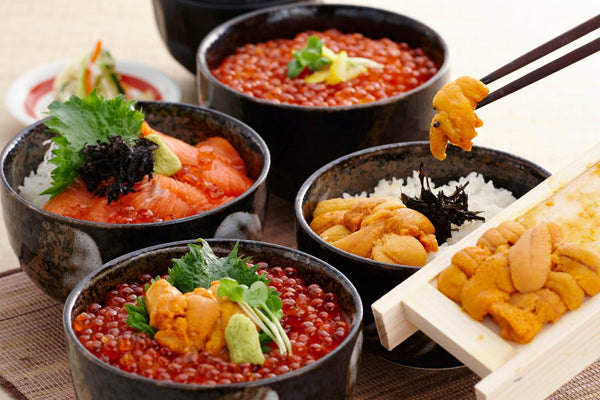
Jump to:
Hokkaido is gaining much deserved attention as a top culinary region in Japan.
The northernmost of the four main islands in the Japanese archipelago, Hokkaido is home to both stunning natural beauty and bustling urban centers. Hokkaido is also known for its delicious and varied cuisine, which is influenced by its unique geography and history.
We recently had the chance to visit Hokkaido and take in many of its offerings, from beautiful scenery to a wide array of delectable dishes.
In this article, we’ll talk about what makes Hokkaido special, with a spotlight on food of course.
Hokkaido: Japan’s Northernmost Island Is A World Away

Before we tuck into Hokkaido cuisine, here’s your briefing on Hokkaido as a geographic and cultural region (if you’re feeling peckish, we’ll forgive you for skipping forward to the food and coming back to this part later).
Hokkaido is located in the north of Japan, just below the 45th parallel and separated from the main island of Honshu by the Tsugaru Strait. From the very northern tip of Hokkaido, on a clear day, you can actually see Russia, which is in close proximity to much of this island.
The second largest island in Japan and least densely populated of the four major islands, Hokkaido is known for its stunning natural beauty, its delicious cuisine, and its unique culture. Hokkaido is home to a vast landscape of mountains, forests, lakes, and rivers. It also features a number of national parks, including the Shiretoko National Park (the largest national park in Japan and a very isolated one at that) as well as Shikotsu-Toya National Park (not far from Sapporo).
Until recently, Hokkaido had no road or rail connections to the main island of Honshu – the fact that one had to go by air or ship to Hokkaido gave it a more isolated feeling than Honshu, Kyushu, or even (in some ways) Shikoku. Today, Hokkaido is still best reached by air from Tokyo and other major airports in Japan (and several international air routes), but bullet train (shinkansen) service now extends to Hakodate – with excellent rail connections to Sapporo (which is slated to get a bullet train extension in 2030) and beyond.
Being situated further to the north, Hokkaido is known for long, cold winters, not dissimilar to the US Midwest (though its mountainous terrain and volcanoes are more akin to the Pacific Northwest or Alaska). Infrastructure is well-built to protect from the elements, however, and Hokkaido is a great destination year-round. Attracting tourists to Hokkaido are the scenery, outdoor activities, vast wilderness, and open feeling – and of course its cuisine.
Seafood, Soup Curry & So Much More: The Foods That Make Hokkaido Famous
Hokkaido's cuisine is influenced by its unique geography, climate, and history. When it comes to fresh seafood, dairy products such as cheese and ice cream, and an annual bounty of fruits and vegetables, Hokkaido is second to none. Hokkaido is also known for a variety of dishes, such as soup curry, ramen, Genghis Khan (the meat feast, not the Mongol ruler), and kaisendon.
Soup Curry: A Hokkaido Twist on Japan’s Adaptation of the Indian Staple

Soup curry is a hearty and flavorful dish that is made with a rich curry broth, vegetables, and meat or seafood. It is a popular comfort food in Hokkaido, and it is said to have originated in Sapporo in the 1960s. Curry itself is not a Japanese invention, of course, but has been imported, adapted, and evolved (as is often the case in Japan) over a span of a century. Bearing little resemblance to its Indian ancestors, standard Japanese curry is typically a thick sauce that’s served over rice.
Soup curry runs a full range of flavors and fashions in Hokkaido, some of which start to look and feel more like Indian curry. It’s typically served with rice, but as its name suggests, this dish is all about the soup form. Soup curry runs the full range from mild to spicy broth, and it can be customized with a variety of toppings such as chicken, pork, beef, seafood, tofu, and/or vegetables.
When considering the climate of Sapporo and surrounding Hokkaido areas, it makes sense that a hearty soup was created to combat the long, cold, harsh winter months. Soup curry warms the body and the soul, as restaurants and home cooks alike will attest, and popular soup curry restaurants in Sapporo (such as the famed Garaku) often have queues out the door with over an hour of wait time not uncommon.
On our recent visit to Sapporo, we opted to book ahead at Soup Curry Syabazo, a modern version of a soup curry restaurant, where we sat at a cozy table (sans shoes, of course) and enjoyed the house special soup curry as well as a flambeed keema curry with melting cheese. The soup curry was piping hot and appropriately spiced (we asked for it “extra spicy”), and featured succulent lamb (a Hokkaido mainstay), springy tofu, and an assortment of seasonal, local vegetables. Like many restaurants and shops in Sapporo, this restaurant is in the B1 level and can be accessed by walking through underground passages from the main train station without ever setting foot in the freezing cold outdoors.
Hokkaido Ramen: Miso, Shio & Shoyu On Full Parade
Speaking of hearty soup that helps one get through the winter months while being enjoyed by enthusiasts year-round, ramen is a star in Hokkaido’s culinary lineup.
Hokkaido is home to some of the best ramen in Japan. The ramen in Hokkaido is known for its thick, rich broth and its generous toppings.
The three main types of ramen in Hokkaido include miso ramen, shoyu ramen, and shio ramen. Each of these ramen soups is made with a stock of pork, pork and fish blend, or newer variants such as chicken or even plant-based ingredients. Noodles can vary but are often wavy or curly, and many local ramen shops serve egg noodles that are more yellowish in color. The seasoning of the broth is then what sets it apart into three distinct categories.
Miso Ramen

Most associated with Hokkaido’s capital city of Sapporo, miso ramen is seasoned with regionally sourced miso (fermented soybeans) and has a distinct brown or even reddish color, depending on the type and amount of miso used. Miso ramen has become a worldwide phenomenon and can be found at ramen shops across Japan, but you’d be hard-pressed to find a better miso ramen than in one of the 1000+ ramen restaurants in Sapporo.
Shoyu Ramen / Soy Sauce Ramen

Shoyu ramen is seasoned with soy sauce (itself often made with Hokkaido kelp), and is the signature dish of the city of Asahikawa (the second largest city in Hokkaido and the northernmost city in Japan). Several shops have been serving shoyu ramen in Asahikawa for a half-century or more, most notably Tenkin, Baikoken, and Aoba (the latter two at which we were fortunate to partake – look for a future article about these and other ramen shops in Hokkaido & beyond!). Asahikawa shoyu ramen is often prepared with burnt lard, keeping the broth hotter for a longer period of time and providing a hearty meal for those bitter winter months.
Shio Ramen / Salt Ramen

Shio means salt in Japanese, but shio ramen might be the least salty of the three Hokkaido ramen varieties. The southern Hokkaido city of Hakodate is the home of shio ramen, which features a clear broth and a more delicate flavor. The noodles here tend to be thinner, and a bowl of shio ramen looks not unlike a Chinese noodle soup (no coincidence, since ramen’s roots are in fact from China).
Kaisendon: Otaru’s Seafood Heaven In A Rice Bowl

Kaisendon is a seafood rice bowl that is piled high with fresh, local, typically raw seafood. The most popular place to enjoy is the port city of Otaru (which we visited during our recent Hokkaido adventure), but kaisendon can be found throughout Hokkaido and further beyond throughout Japan.
A delicious and visually stunning dish that’s a must-try for any seafood lover, kaisendon is typically made with a variety of ingredients such as salmon, tuna, shrimp, scallops, crab (cooked), ikura (salmon roe) and/or uni (sea urchin). It is often garnished with pickled ginger, wasabi, and shiso (perilla leaf).
We took a 45-minute train ride from Sapporo station to Otaru, and within a few minutes’ walk we were already walking into the Sankaku Market. This spot is a must-see in Hokkaido, especially for those who crave fresh, local, seasonal seafood. On display at dozens of stalls are a mind-blowing array of seafood, including giant tanks of live crab, as well as oysters, fish, scallops, sea urchin, and much more.
Despite arriving around 9am and thinking we’d beaten the crowds, lines were already common at many of the eateries within the market. But we walked further ahead and were greeted by a friendly gentleman at the Kawashima seafood shop. Like many of the family-run establishments in Sankaku Market, this shop sells live crabs and other fresh seafood but also has a dining area where you can enjoy masterful preparations of the local catch.
We opted for a 4-item kaisendon bowl that included uni, ikura, crab, and scallops. It was a visual feast right off the bat, with the color balance and fresh “pop” of the ingredients making for a highly photogenic moment. The flavor and texture matched the imagery, of course – truly a taste of the ocean served fresh on a rice bowl. Even the wasabi and miso soup were of high quality, and we also partook in a steamed jumbo oyster as well as raw Botan shrimp. Our Otaru experience was an unforgettable one thanks to the Kawashima family shop, and we’ll be sure to come back again!
Hokkaido Sweets: Otaru, Sapporo & Around the Island

After our Otaru seafood feast, we were hankering for something sweet – after a good walk, of course, getting some exercise along Otaru’s famous canals before heading to the main shopping street to sample some treats.
The most well-known sweets shop in Otaru is LeTAO, which has multiple locations in town and many others across Hokkaido and elsewhere in Japan. LeTAO did not disappoint. These sweets made for a great souvenir to take back to friends, family, and coworkers – but many of the items (cheese and chocolate-based) posed a melty risk, so (oh well, wink wink) we had to enjoy them within a day or two.
Much of our sweets haul came from other shops in Hokkaido, most notably Rokkatei, Kinotoya, and Shiroi Koibito. These are long-standing favorites for Hokkaido treats that are enjoyed by Japanese across the country. Not in Japan? No problem! We’ve got them available for purchase right here (as well as some other faves from Hokkaido):
- Rokkatei Marusei Butter Sandwich Cookies
- Kinotoya Sapporo Nogakko Hokkaido Milk Biscuits
- Ishiya Shiroi Koibito Cookies
- Yoshimi Sapporo Okaki Oh! Yakitokibi Corn Snacks
Interested in reading more about Japan’s sweet souvenirs? Check out our article about Top 5 cookies and local experiences. It even talks about ROYCE’, whose airport shop is a must before leaving Hokkaido – or, if you’re not heading to/from Hokkaido in the near future, we’ve got ROYCE’s famous potato chip chocolate and baton cookies available for purchase from the US and elsewhere around the world.
Three Other Hokkaido Foods Not To Miss
Between ramen, kaisendon, and sweets, those alone seem reason enough to make your way to Hokkaido, right?
But wait, there’s more!
(so much more)
We enjoyed a variety of delights (and paid a small price in weight gain, hello again gym!) during our week in Hokkaido. From amazing sushi and local beef to seasonal summer corn and a plethora of sweets (from local sweets shops as well as the beloved regional konbini Seicomart), the culinary adventure of endless possibilities seemed to end too soon.
We’ll definitely be back, however, and in the meanwhile will be dreaming (and drooling) over the following three standouts.
Soft Cream

Soft cream is a smooth and creamy ice cream that is made with fresh Hokkaido milk. It is a popular treat in Hokkaido, and it is available in a variety of flavors. Soft cream is often served in a cone or cup, and comes in standard flavors as well as more exotic ones. We enjoyed the famous Shiroi Koibito soft cream in Sapporo, and also found a local farm treat of camembert soft cream (oh so cheesy good, but melts oh so quickly so wear a bib!).
Yubari Melon

Yubari melon is a sweet and juicy melon that is grown in the Yubari region of central Hokkaido. It is considered to be one of the finest melons in the world, and it is often given as a gift (the best of the best Yubari melons can fetch upwards of $100 in high-end Tokyo & Osaka shops. Yubari melons are typically round and have a golden yellow skin. They have a sweet and honey-like flavor, and they are often featured in dessert arrays in fine restaurants.
Genghis Khan

Genghis Khan is a savory dish that is made with thinly sliced lamb that is grilled on a hot plate. It is served with onions, cabbage, and a series of dipping sauces. The dish Genghis Khan is said to have originated in Mongolia, is named after Genghis Khan, the first ruler of the Mongol Empire. We enjoyed a Genghis Khan feast at Matsuo in Sapporo, booking ahead and served a memorable meal by super friendly staff.
Hokkaido’s Famous Foods Await You
These are just a few of the many famous Hokkaido foods that you can enjoy.
If you’re planning an upcoming visit to Japan, Hokkaido is a must – both for its scenery as well as for its memorable food scene.
Not in Japan or coming here anytime soon? No worries! We’ve got your Hokkaido (and other Japanese) food cravings covered with a wide array of sweet and savory delights. Feel free to browse our shop with the handy search bar at the top of the page. Don’t see what you’re looking for? Let us know, we’ll do our best to find it for you.
Happy food and travel adventures!


0 comments